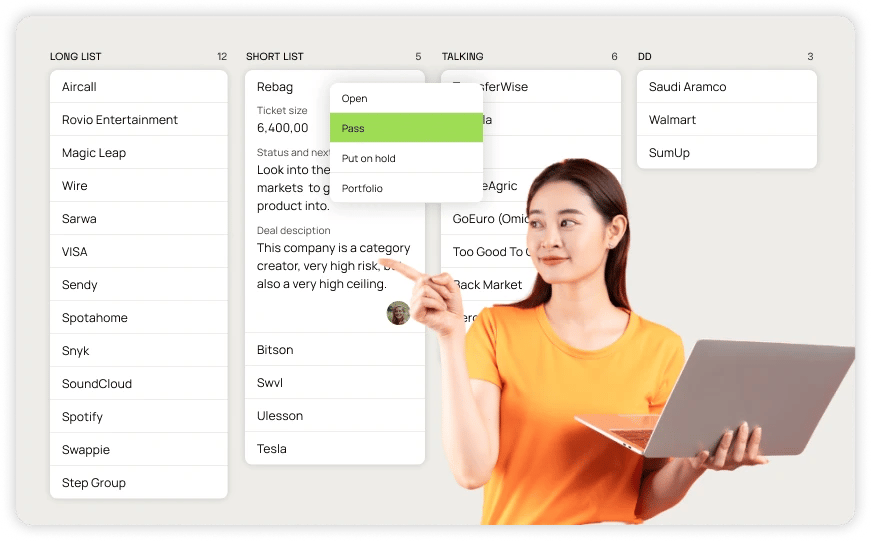Having talked to a few hundred VC and PE funds over a period of two years, we decided it’s time to share some of the most important lessons learned in selecting the right tool for the job. Venture capital CRM seems to be one of the top queries out there, so we figured it’s only fair we help out by creating a list of important things to think about when it’s time to decide what platform to adopt.
- A VC fund should not be run with sales tools
The best Venture Capital CRM shares a lot with a typical sales CRM. You do want a pipeline, you do want deals, you do want to manage your contacts and you do need connectivity with your emails. But who needs inventory, pricing, hour tracking, margin calculation, product catalogues and other nonsense for investors? More clutter = more problems.
A sales CRM might get you halfway there but there are a few things you need to consider when you’re doing VC and not sales:
- How do I easily create, view & kill deals on all devices?
- How do I track if my teammates have already spoken with these guys?
- How do I easily put together relevant reports to my team members and my investors?
- How do I easily communicate my deals with different stakeholders? Can I create reports & investment memos automatically?
- How do I easily collaborate on deals with different stakeholders?
- How to I offload some of my boring work to someone else?
- How do I capture deals and deal data online?
- How do I manage my deals with different access privileges?
Most of these things require time-consuming customization if built on a sales CRM. A good CRM for venture capital and private equity will have all of these out-of-the-box.
- Share information with your key stakeholders
Your team will have full access to all the deals on the platform. Every once in a while, you might also want to share information with your lawyers, co-investors, etc. or invite the target company to fill in some information that was missing. You select what to share with whom. It is crucial that this process is as fluent as possible, since this is something you might have to do more than you originally expected.
- Report to your own investor(s)
You need to make sure the capabilities of your CRM don’t stop at the end of the deal funnel. If your LP’s want to see custom reporting on a particular vertical with very specific KPI’s, you’d much rather create the report with a few clicks than scrape it together from data that’s scattered across your inbox, project management software, CRM and portfolio management tool.
- Think of deals first - not companies or people
We’ve seen quite a few approaches to deal flow (since there always tends to be some type of a legacy system we need to transfer the deals from when people sign up to use Zapflow). Some of the approaches are based on contacts, others on companies. We feel it’s best to go deals (i.e. investment opportunities) first. Why? Because most likely you will see situations where you have multiple deals for the same company / asset. After all, on any given transaction you may have multiple investment scenarios with a different set of co-investors. And the follow-on investment is going to be a stand-alone investment decision in any case.
Of course you do record data on the people and companies related to a particular deal, but in our opinion, the deal should be front and center since that’s ultimately what you’re deciding on.
- Publish newsletters and execute outbound marketing campaigns using your favorite platform
Your CRM should be able to export a CSV or an Excel sheet you can filter by tags and easily allow you to upload the list to MailChimp, for example. This is something you might not really consider before it’s time to send out your first campaign and by then, it might be too late to switch to another platform.
- Stay on top of things and keep your data in one place
You want your whole team to be up to speed on who did what and when, where the deal is headed and what the next steps are. You also want to make sure sharing documents, notes, emails and assigning tasks is as easy as it can be.
- End-to-end deal flow management with one tool
No one wants more apps to manage. No matter what tool you choose, you want to make sure it covers your deal flow from the very beginning all the way to portfolio reporting. A single ground-truth database is the way to go here.
We hope this will turn out to be useful to you as you’re doing DD on the software platforms available out there. If some of the themes listed struck a chord, we’d be more than happy to jump in a quick demo and share some of the best practices we’ve figured out while helping our customers manage their deal flow more efficiently.
Get in touch today!



